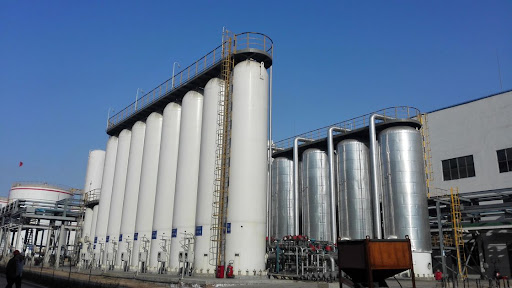Adsorption is the name of the spontaneous phenomenon of attraction that a molecule from a fluid phase experiences when it is close to the surface of a solid, named adsorbent. Adsorbents are porous solids, preferably having a large surface area per unit mass. Since different molecules have different interactions with the surface of the adsorbent, it is eventually possible to separate them.
The feed stream is put into contact with the adsorbent that is normally packed in fixed beds. The less adsorbed (light) component will break through the column faster than the other(s). In order to achieve separation, before the other (heavy) component(s) breaks through the column, the feed should be stopped and the adsorbent should be regenerated by desorbing the heavy compound. Since the adsorption equilibrium is given by specific operating conditions (composition, temperature and pressure), by changing one of these process parameters it is possible to regenerate the adsorbent. When the regeneration of the adsorbent is performed by reducing the total pressure of the system, the process is termed pressure swing adsorption (PSA), the total pressure of the system “swings” between high pressure in feed and low pressure in regeneration.
Over the years it has been demonstrated that PSA technology can be used in a large variety of applications: hydrogen purification, air separation, OBOGS (on-board gas generation system), CO2 removal, noble gases (He, Xe, Ar) purification, CH4 upgrading, n-iso paraffin separation, and so forth. The PSA processes are normally associated to low energy consumption when compared to other technologies.
The most important industrial applications of PSA processes are air separation and hydrogen purification.
The separation of nitrogen and oxygen from air takes place in an adsorber vessel filled with carbon or zeolite molecular sieve. This is based on the fact of different kinetic rate of diffusion of oxygen or nitrogen molecules into the pore structure of the molecular sieve.
FARAN supplies nitrogen and oxygen generators based on the Pressure Swing Adsorption (PSA) technology for both industrial and medical applications.
Four main stages of FARAN’s oxygen generators’ are described below:
- Air (78% nitrogen, 21% oxygen, <1% argon) is first filtered, degreased and dried. Then it will be fed to the first column at a pressure higher than atmospheric.
- Air will pass through the molecular sieves where nitrogen is adsorbed by zeolite (ZMS). This will increase oxygen’s concentration up to 93%.
- Out of the molecular sieve, the oxygen produced is sent through the buffer tank via a multifunction block. Nitrogen is released via a silent escape and forced back outside.
- Part of the oxygen produced is used to help the nitrogen desorption of one vessel while the other ensures oxygen production (and vice versa).
Moreover, FARAN’s nitrogen generator function is as follows:
- Air (78% nitrogen, 21% oxygen, <1% argon) is first filtered, degreased and dried. Then it will be fed to the first column at a pressure higher than atmospheric.
- Air will pass through the molecular sieves where oxygen is adsorbed by carbon molecular sieve (CMS). This will make the exiting stream richer in nitrogen. When the adsorbent packed in the first column is saturated and cannot adsorb more oxygen, the feed is directed to the second column.
- In order to release part of the oxygen adsorbed in first column, the flow direction is reversed and the total pressure of the column is reduced by venting to atmosphere. Oxygen is desorbed from the adsorbent and released and at the end of this step, the gas phase inside the column is rich in oxygen.
- To additionally remove oxygen from the column, a purge step (or light gas recycle) is used. The purge consists of recycled part of the enriched air from the other column which is flowing by the pressure differential between the two columns. After the adsorbent is ready to load more oxygen, the overall pressure of the system should be restored.

FARAN’s tailor made PSA generators allow you to produce the gas exactly where you need it, when you need it and in the quality that you need. We also design custom-made generator systems for cases where our standard range of generators does not fit your specific requirements.

